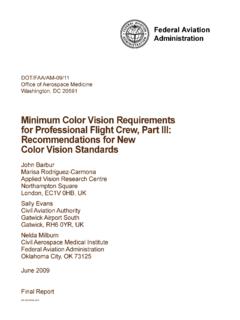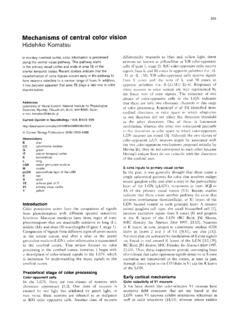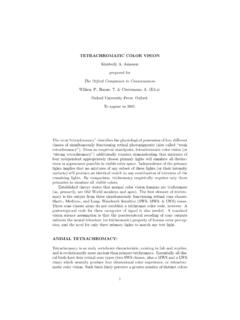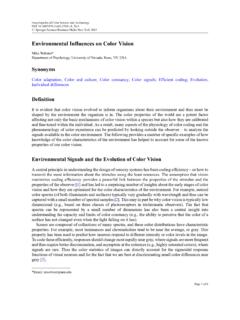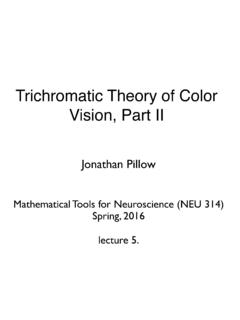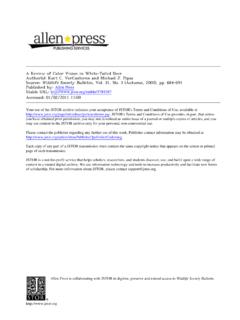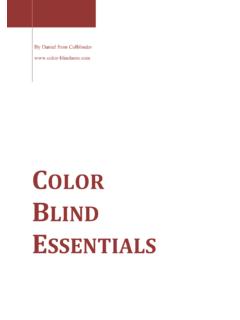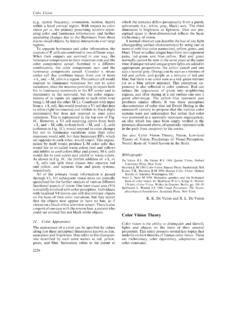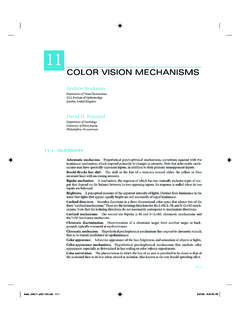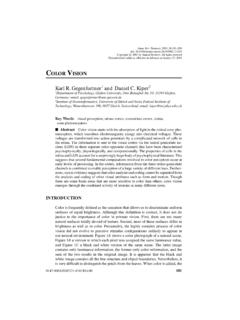Transcription of Medical Guidelines - OHCAccess Home
1 2 Medical Guidelines for Transportation Security Officers Authority: The Aviation and Transportation Security Act established the authority of the TSA Administrator to determine physical and psychological requirements for the security-screening workforce. Mission Impact: TSA developed Medical Guidelines for clinical evaluations and fitness for duty determinations to ensure that Federal screeners are able to provide the best security possible. The evolution of security operations from process-driven procedural-based security to risk-based intelligence driven security affirms the need for a resilient screening workforce whose readiness and fitness is measurable, demonstrable, and enforceable. Purpose: The Medical Guidelines provide a responsive connection between a Medical condition and a predictable degree of job performance, conduct and mission readiness. The Medical Guidelines are designed to reflect the underlying correlation between recognized Medical conditions and safe and effective job performance.
2 The Medical Guidelines apply to Transportation Security Officers, Lead Transportation Security Officers, Supervisory Transportation Security Officers, Security Training Instructors, and Behavior Detection Officers. 3 Medical Guidelines for a Mission Ready Workforce Contents Guidelines .. Eyes and vision .. 4 Hearing .. 4 Nose, pharynx, larynx and trachea .. 5 Lung diseases .. 5 Cardiovascular 6 Abdominal organs .. 9 Renal diseases .. 9 Musculoskeletal diseases .. 10 Neurological disorders .. 11 Diabetes .. 12 Sleep disorders .. 13 Psychiatric disorders .. 14 Medications .. 16 Miscellaneous issues .. 16 Job Eyes and vision Distant visual acuity, corrected or uncorrected: 20/30 or better binocularly Intermediate visual acuity (at 22 inches), corrected or uncorrected: 20/30 or better binocularly Near visual acuity (at 12 inches), corrected or uncorrected: 20/40 or better binocularly Field of vision : Provide restrictions if the horizontal meridian is less than 120 degrees binocularly Provide restrictions for monocular vision unless the monocular vision has lasted for a minimum of 6 months color vision : Provide restrictions for moderate or severe color vision deficiency using a Farnsworth D-15 test.
3 Tinted lenses are not allowed to meet the color vision standard Refractive surgery: Provide restrictions if any of the following criteria are present: significant haze (+2 or less is acceptable) glare, halos, starbursts, or ghosting microstriae that affect vision dryness that affects vision loose epithelium, diffuse lamellar keratitis, or active infection unstable refraction (more than diopter of change between documented refractionsat least 2 weeks apart) using steroid eye Hearing Initial testing via air conduction must be performed at 500, 1000, 2000 and 3000 Hz in each ear. If wearing hearing aids, an assessment by an audiologist must be performed. The job tasks that are hearing dependent require distinguishing differences in tones on the walk through metal detector, communicating with passengers, and overhearing quiet conversations among passengers. These types of tasks are performed in noisy environments.
4 The hearing requirement is at an average 25dB HL (hearing level) or less in each ear for the following frequencies: 500, 1000, 2000 and 3000 Hz in each ear. If individual does not meet the acceptable criteria, refer individual to an audiologist for testing in a sound controlled booth. , after assessment by an audiologist, the individual met the criteria listed above, theindividual does not need restrictions. 5 2. If, after testing by the audiologist, the individual does not meet the criteria listed in the above, test the individual s Speech Reception Threshold (aided or unaided) and the individual s Speech Understanding in the Presence of Noise (aided or unaided). Unaided Speech Reception Threshold for each ear Test each ear under headphones. Measure the Speech Reception Threshold for each ear. Provide restrictions if the Speech Reception Threshold is more than 30 dB in one or both ears. Aided Speech Reception Threshold for each ear Test aided ear with plugged opposite ear in a sound field.
5 Measure the Speech Reception Threshold for each ear. Provide restrictions if the Speech Reception Threshold is more than 30 dB in one or both ears. Speech Understanding in the Presence of Noise Bilateral Hearing (aided or unaided) This test addresses an individual's ability to understand speech in the presence of noise. This test provides a practical measure of an individual's ability to understand speech in a noise controlled environment. Follow the steps listed below: A. Set up one loudspeaker in a calibrated sound attenuated booth at a distance of one (1) meter from the individual, with the individual facing the speaker. The individual may move his/her head to maximize performance. B. Use a signal-to-noise ratio of +10 dB, with the signal and the noise simultaneously emanating from a single speaker. C. Deliver the speech stimuli at 60 dB HL (hearing level) and deliver the noise at 50 dB HL. D. If a speech understanding score of 70% or better is obtained, test may be terminated.
6 If a score of less than 70% is obtained, vary presentation level up or down to achieve maximum score, not to exceed 75 dB HL. Signal-to-noise ratio of + 10 dB must be maintained. Provide restrictions if the correct responses are less than 70%. Nose, pharynx, larynx and trachea Provide restrictions for aphonia Provide restrictions for tracheostomy if it limits the ability to communicate effectively Lung diseases Asthma Provide restrictions if FEV1 < 60% of predicted value COPD Provide restrictions if FEV1 < 60% of predicted value Other conditions Provide restrictions for current pneumothorax 6 Provide restrictions for active hemoptysis Provide restrictions for pulmonary hypertension Provide restrictions for contagious tuberculosis Provide restrictions if pulse oximetry < 90% on room air at rest Provide restrictions if pulse oximetry < 90% on room air with exertion Cardiovascular diseases Hypertension Provide restrictions for stage II hypertension (SBP 160-179 or DBP 100-109) or stage III hypertension (SBP > 180 or DBP > 110)
7 Provide restriction for any end-organ damage caused by hypertension (including stroke, coronary artery disease, left ventricular hypertrophy, atrial fibrillation, heart failure, nephropathy, retinopathy or aortic aneurysm), unless a normal exercise stress test is obtained at a level of at least METs Provide restrictions if the 10-year risk of ASCVD (atherosclerotic cardiovascular disease) is 10% or more on the American Heart Association ASCVD calculator (available at ), unless a normal exercise stress test is obtained at a level of at least METs Evaluate, on an annual basis, the 10-year risk of ASCVD (atherosclerotic cardiovascular disease) using the American Heart Association ASCVD calculator (available at ) Coronary artery disease Provide restrictions for coronary artery disease (including myocardial infarction) unless all the following conditions are met: No angina Left ventricle ejection fraction of 40% or more No ischemia on imaging stress test that reaches a level of at least METs Stable regimen of cardiovascular medications for the past 30 days Treatment of modifiable risk factors Recovery period: one month after percutaneous coronary intervention, 3 monthsafter myocardial infarction, 6 months after coronary artery bypass graft surgery Compliance with treatment Stress test interpretation Provide restrictions if any of the following criteria were found during the stress test (until further evaluation by a cardiologist).
8 Inability to reach METs Symptoms of ischemia Ischemic changes on electrocardiogram Significant arrhythmias (frequent PVCs, couplets, ventricular tachycardia) orconduction abnormalities Hypertensive response to exercise (SBP > 250 mmHg or DBP > 115 mmHg) Exercise-induced Heart failure Provide restrictions for heart failure unless all the following conditions are met: Compliance with treatment Left ventricle ejection fraction of 40% or more No ischemia on imaging stress test that reaches a level of at least METs NYHA Functional Classification of I or Hypertrophic cardiomyopathy Provide restrictions for hypertrophic cardiomyopathy unless all the following conditions are met: Maximal left ventricle wall thickness < 30 mm No history of unexplained syncope No history of cardiac arrest No history of sustained or non-sustained ventricular tachycardia Left ventricle ejection fraction of 40% or more No abnormal exercise blood pressure during exercise stress test [defined aseither a failure to increase by at least 20 mm Hg or a drop of at least 20 mm Hgduring effort] Dilated cardiomyopathy Provide restrictions for dilated cardiomyopathy unless all the following conditions are met: No symptoms of heart failure Left ventricle ejection fraction of 40% or more No ischemia on imaging stress test that reaches a level of at least METs No history of unexplained syncope No history of cardiac arrest No history of spontaneous ventricular tachycardia Arrhythmias Provide restrictions for atrial fibrillation or atrial flutter unless all the following conditions are met.
9 Reversible conditions (such as hyperthyroidism) have been ruled out No structural heart disease on echocardiogram Left ventricle ejection fraction of 40% or more No ischemia on imaging stress test that reaches a level of at least METs Appropriate rate controlAfter an ablation for atrial fibrillation or atrial flutter: Return to unrestricted duty 4 weeks after ablation if asymptomatic Provide restrictions for supraventricular tachycardia unless all the following conditions are met: Reversible conditions (such as hyperthyroidism) have been ruled out No structural heart disease on echocardiogram Left ventricle ejection fraction of 40% or more Episodes last less than 10 seconds after successful ablationAfter an ablation for supraventricular tachycardia: Return to unrestricted duty 4 weeks after ablation if asymptomatic Provide restrictions for Wolff-Parkinson-White Syndrome unless all the following conditions are met: Appropriate rate control No structural heart disease on echocardiogram Left ventricle ejection fraction of 40% or moreAfter an ablation for supraventricular tachycardia: Return to unrestricted duty 4 weeks after ablation if asymptomatic Provide restrictions for ventricular tachycardia except in the following cases: Successful ablation to treat the ventricular tachycardia (return to unrestrictedduty after 4 weeks, with normal electrophysiological study) Non-sustained monomorphic ventricular tachycardia with rate less than 150beats per minute and no symptomsProvide restrictions for history of ventricular fibrillation Valvular heart disease Provide restrictions for valvular diseases unless all the following conditions are met.
10 No symptoms of heart failure No angina No syncope Left ventricle ejection fraction of 40% or more 9 No signs or symptoms of arterial emboli Compliance with Other conditions Provide restrictions for arrhythmogenic right ventricular cardiomyopathy until electrophysiology consultation has been obtained Provide restrictions for Brugada syndrome until electrophysiology consultation has been obtained Provide restrictions for long QT syndrome until electrophysiology consultation has been obtained Provide restrictions for treatment with an automatic implantable cardiac defibrillator Provide restrictions for peripheral vascular disease resulting in symptomatic claudication Provide restrictions for thoracic aortic aneurysm > cm unless all the following conditions are met: Surgical consultation has been obtained Compliance with treatmentProvide restrictions for abdominal aortic aneurysm > 4 cm unless all the following conditions are met: Surgical consultation has been obtained Compliance with treatmentProvide restrictions for carotid artery stenosis > 60% Provide restrictions for syncope within the past 6 months unless a specific cause has been found and successfully treated An individual does not need restrictions for treatment with a pacemaker.




